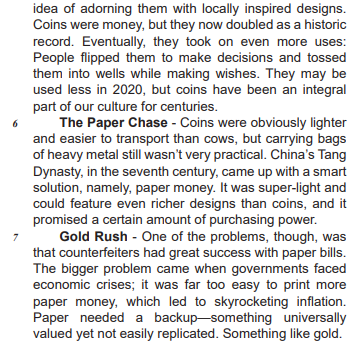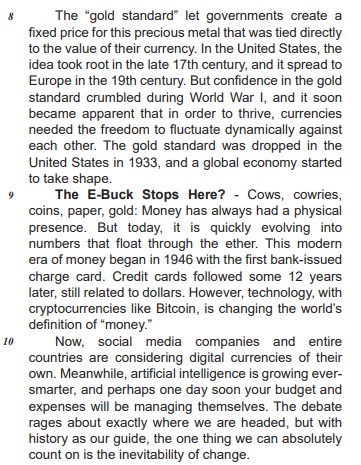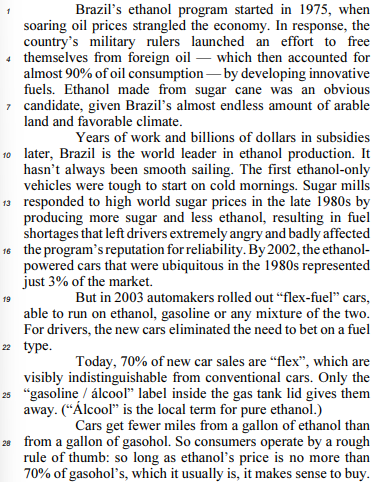Questões de Concurso
Sobre oposto | opposite em inglês
Foram encontradas 74 questões
Read the lyrics carefully and answer the following questions:
The Times They Are A-Changin' (Bob Dylan)

Read the lyrics carefully and answer the following questions:
The Times They Are A-Changin' (Bob Dylan)

When a person (or team or firm or government) decides how to act in dealings with other people (or teams or firms or governments), there must be some cross-effect of their actions; what one does must affect the outcome for the other. For the interaction to become a strategic game, however, we need the participants’ mutual awareness of this cross-effect. What the other person does affects you; if you know this, you can react to his actions, or take advance actions to forestall the bad effects his future actions may have on you and to facilitate any good effects, or even take advance actions so as to alter his future reactions to your advantage. If you know that the other person knows that what you do affects him, you know that he will be taking similar actions. And so on. It is this mutual awareness of the cross-effects of actions and the actions taken as a result of this awareness that constitute the most interesting aspects of strategy.
When each participant is significant in the interaction, either because each is a large player to start with or because commitments or private information narrow the scope of the relationship to a point where each is an important player within the relationship, we must think of the interaction as a strategic game. Such situations are the rule rather than the exception in business, in politics, and even in social interactions. Therefore, the study of strategic games forms an important part of all fields that analyze these matters.
Avinash Dixit et al. Games of strategy.
New York: W.W. Norton & Coadapted, 2015 (adapted).
Considering to the preceding text, judge the item that follow.
The words “forestall” and “facilitate” (third sentence of the text) work as antonyms and are being used to convey opposite reactions.
Read the text II to answer the question.
TEXT II
JOHN LAURENS:
The ten-dollar Founding Father without a father
Got a lot farther by workin' a lot harder
By bein' a lot smarter
By bein' a self-starter
By fourteen, they placed him in charge of a trading charter
THOMAS JEFFERSON:
And every day while slaves were being slaughtered and carted
Away across the waves, he struggled and kept his guard up
Inside, he was longing for something to be a part of
The brother was ready to beg, steal, borrow, or barter
[…]
AARON BURR:
Well, the word got around, they said, "This kid is insane, man!"
Took up a collection just to send him to the mainland
"Get your education, don't forget from whence you came, and
The world's gonna know your name! What's your name, man?"
Excerpt from the musical Hamilton, with lyrics by Lin-Manuel Miranda.
Read Text | and answer questions 05 to 13.
Netflix is trying to prove to the world that it's all grown up
Netflix is trying to persuade Wall Street that it is now all grown up. After squeezing out millions of additional subscribers via its password sharing crackdown and through the introduction of cheaper advertiser-supported plans, the streamer knows that its growth spurts are coming to an end — and now it wants investors to stop obsessing over those pesky membership numbers and instead focus on other metrics.
"In our early days, when we had little revenue or profit, membership growth was a strong indicator of our future potential. But now we're generating very substantial profit and free cash flow. We are also developing new revenue streams like advertising and our extra member feature, so memberships are just one component of our growth", Netflix told shareholders as it reported quarterly earnings.
To that end, Netflix said that it will no longer report quarterly subscriber numbers, starting in 2025. Alas, the metric that Wall Street has forever judged Netflix on — the metric that prompted legacy media companies to burn endless piles of cash in their bids to compete with the streamer — will be retired. The decision to shut off transparency on the metric represents a significant turning point in the streaming revolution. For years, Netflix has prided itself on being extraordinarily transparent. Now it is aiming to hold its cards closer to its chest. And given that streaming giant is the trendsetter in the space, one could expect that other media companies will be inspired by the company's move and also opt to cease reporting such data.
To be fair, what Netflix is saying isn't necessarily off base either. As the company shifts its business model away from subscriptions and toward advertising and other revenue streams, it makes sense to consider how much time users are spending on the service. The more content a user consumes on Netflix, the more likely they are to continue paying for the service, and the more money Netflix then makes from that single subscriber. "We're focused on revenue and operating margin as our primary financial metrics — and engagement (i.e. time spent) as our best proxy for customer satisfaction,” Netflix underscored in its letter to shareholders.
Regardless, less transparency in an already opaque industry is not ideal. The walled garden of streaming already lacks the same detailed viewership data that Nielsen collects on linear television broadcasters. Now, visibility into the streaming world will get even dimmer.
The announcement from Netflix managed to overshadow its otherwise stellar quarter. The company handily beat expectations and added a staggering 9.3 million subscribers, meaning it now boasts nearly 270 million in total. Netflix also beat analyst expectations on both earnings and revenue. However, it wasn't all good news. Netflix forecasted its subscriber growth to be lower in quarter two, chalking it up to “typical seasonality.” That led the stock to slide nearly 5% in after-hours trading.
Whether "typical seasonality” is solely to blame, or whether the streamer is simply starting to hit a ceiling, is hard to tell. Perhaps it is a mix of both. Whatever the cause, the stock sliding on the less-than-ideal outlook is a prime example of why Netflix wants Wall Street to stop focusing on its subscriber numbers. And, in one year's time, investors won't have a choice.
Adapted from: https://edition.cnn.com/2024/04/19/media/netflix-subscription-numbers/index.html
Analyze the following lists of words.
List 1
1.1 Vexing
1.2 Annoying
List 2
2.1 Irksome
2.2 Nettlesome
List 3
3.1 Pleasing
3.2 Delightful
The list(s) in which at least one word is an antonym of the adjective "pesky” is/are:
READ THE FOLLOWING TEXTTO ANSWER QUESTION.
TEXT 4
According to the Brazilian National Education Guidelines and Framework Law enacted in 2017, English language teaching is mandatory from the sixth year of elementary school until the last years of high school. However, the curriculum does not guarantee that all Brazilian students will receive English teaching. In 2013, Data Popular, a Brazilian research institute, drafted a report for the British Council analyzing the problems concerning knowledge of English in Brazil. The report claims that the low level of English proficiency amongst Brazilians reflects the educational opportunities available in the country […].
To understand the reasons why English teaching does not seem efficient for all students, it is important to highlight the English language teaching provision in Brazil. Formal English teaching in Brazil takes place in four different contexts: English schools, bilingual schools, regular private schools, and public schools. In general, people who wish to learn English believe that effective learning occurs only in private English schools or bilingual schools because the structure (the teaching methods and the quality of support materials) is more likely to provide successful learning. The focus in those institutions is on oral expression. Learners have more exposure to the target language because classes are taught entirely in English, and teachers are usually well trained to comply with that requirement. In addition, groups are smaller, so students can receive personal support and enjoy a comfortable learning environment, not to mention access to multimedia resources.
(Adapted from: https://academic.oup.com/eltj/75/1/103/6169556)
Read Text I and answer the fourteen questions that follow it
Text I The “literacy turn” in education: reexamining
what it means to be literate
In response to the phenomena of mass migration and the emergence of digital communications media that defined the last decade of the 20th century, the New London Group (NLG) called for a broader view of literacy and literacy teaching in its 1996 manifesto, A Pedagogy of Multiliteracies: Designing Social Futures. The group argued that literacy pedagogy in education must (1) reflect the increasing cultural and linguistic diversity of the contemporary globalized world, and (2) account for the new kinds of texts and textual engagement that have emerged in the wake of new information and multimedia technologies. In order to better capture the plurality of discourses, languages, and media, they proposed the term ‘multiliteracies’.
Within the NLG’s pedagogy of multiliteracies, language and
other modes of communication are viewed as dynamic resources
for meaning making that undergo constant changes in the
dynamics of language use as learners attempt to achieve their
own purposes. Within this broader view of literacy and literacy
teaching, learners are no longer “users as decoders of language”
but rather “designers of meaning.” Meaning is not viewed as
something that resides in texts; rather, deriving meaning is
considered an active and dynamic process in which learners
combine and creatively apply both linguistic and other semiotic
resources (e.g., visual, gesture, sound, etc.) with an awareness of
“the sets of conventions connected with semiotic activity [...] in a
given social space” (NLG, 1996, p. 74).
Grounded within the view that learning develops in social,
cultural, and material contexts as a result of collaborative
interactions, NLG argued that instantiating literacy-based
teaching in classrooms calls on the complex integration and
interaction of four pedagogical components that are neither
hierarchical nor linear and can at times overlap: situated practice,
overt instruction, critical framing, and transformed practice. […]
Although the NLG’s pedagogy of multiliteracies was
conceived as a “statement of general principle” (1996, p. 89) for
schools, the group’s call for educators to recognize the diversity
and social situatedness of literacy has had a lasting impact on
foreign language (FL) teaching and learning. The reception of the
group’s work along with that of other scholars from critical
pedagogy appeared at a time when the field was becoming less
solidly anchored in theories of L2 acquisition and more interested
in the social practice of FL education itself. In the section that
follows, we describe the current state of FL literacy studies as it
has developed in recent years, before finally turning to some very
recent emerging trends that we are likely to see develop going
forward.
(Adapted from: https://www.colorado.edu/center/altec/sites/default/files/ attachedfiles/moving_toward_multiliteracies_in_foreign_language_teaching.pdf)
Julgue o item que se segue.
The antonyms of the adjectives beautiful, dead, dry,
heavy, and rough are, respectively, ugly, alive, wet, light,
and smooth.



Available at: https://www.synchronybank.com/blog/brief-history-of-money/. Retrieved on: Sept 10, 2022. Adapted.

Refer to the above text to judge the following item.
“fewer” (ℓ.27) is the opposite of more.
1. noisy – ugly – terrible – friendly. 2. safe – calm – annoying – quiet. 3. curly – narrow – little – small. 4. street – across – between – in front of.
Text V
Language Assessment and the new Literacy Studies
Some Final Remarks
Planning language assessment from a structuralist view of language has been a fairly easy task, since it aims at testing the correct use of grammar and lexical structures. This has been a very comfortable way to evaluate students’ performance in many regular schools or language institutes due to the stability of standardized answers. From the perspective of the new literacy studies, the comfort of teaching and assessing objective and homogeneous linguistic contents is replaced by a wider spectrum of language teaching and assessing possibilities, whose key elements turn to be difference and critique. Typical activities based on this new approach would enable students to make and negotiate meanings in a much more flexible way, corroborating the novel notion of unstable, dynamic, collaborative and distributed knowledge.
The inclusion of contents of such nature in language assessments may be, at a first glance, a very laborious process due to the fact we are simply not accustomed to that. Actually, we sometimes find ourselves deprived from the teaching skills necessary to apply a more critical teaching approach, a fact that is much the results of our positivist educational background.
Nonetheless, since the emergent digital epistemology will require subject more capable of designing and redesigning meaning critically towards a great deal of representational modes, we need to reconsider our teaching approaches, go further and seek theories that take such issues into account. By redefining the notions of language and knowledge, we, thus, assume that the new literacy studies from the last decades may offer very good insights to the field of foreign language teaching.
The re-conceptualization of language assessment according to the new literacies project presented in this paper does not intend to suggest prompt fixed answers, but it takes the risk of outlining possible activities, signaling certain changes regarding its characteristics and contents, as previously shared.
The increasing importance of the new literacy and multiliteracies studies and their fruitful theoretical insight for the rethinking of pedagogical issues invite us to review our foreign language teaching practices in a different perspective. By sharing some of our local findings, we attempt to corroborate the collaborative and distributed knowledge discussed by the literacies theory itself and hope to be contributing to the new educational demands of the emerging epistemological basis.
From: DUBOC, A.P.M. Language Assessment and the new Literacy Studies. Lenguaje
37 (1), 2009. pp. 159-178, p. 175-176.
The opposite of the superlative form THE BEST is: